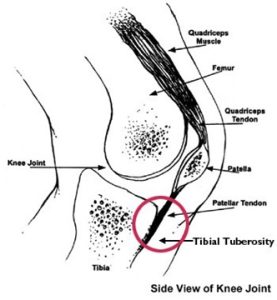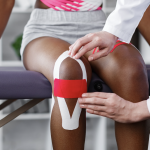Osgood-Schlatter’s disease (OSD) is a fairly common condition in adolescents that results in knee pain and loss of function. Typically, it is characterized by pain and inflammation just below the knee, especially in individuals that are active and engage in sports and other physical activities. As a result, this condition can be quite disruptive to a young athlete, who suddenly finds themselves unable to participate fully in practices or games due to pain. Specifically, in this blog, we will discuss causes, symptoms, and effective physiotherapy treatment of OSD.
What causes Osgood-Schlatter’s Disease?
OSD is primarily an overuse injury causing the tendon under the knee, the patellar tendon, and the part of the bone it attaches to, the tibial tuberosity to become painful and inflamed. Eventually, the tendon and bone experience repetitive traction and strain through high intensity movements such as running and jumping, and the tendon pulls on the still developing bone. As a result, OSD is one of the most common causes of knee pain in adolescents.
Risk factors include:
- Participation in sports like basketball, soccer, volleyball, gymnastics, track and field and similar activities
- Males 12-15, girls 8-12
- Experienced a recent growth spurt
In summary, here is a link that you may find helpful: https://www.hopkinsmedicine.org/health/conditions-and-diseases/osgoodschlatter-disease
What are the signs and symptoms of Osgood Schlatter’s Disease?
- Occasionally, a bigger bump than normal at the tibial tuberosity
- Painful to put pressure on the tibial tuberosity
- Knee pain located just below the kneecap
- Pain that worsens with pressure around the tibial tuberosity and with physical activities
- No acute trauma, pain came on slowly over time
How does physiotherapy help?
If you think that your child is experiencing OSD, consulting a physiotherapist is essential for an accurate diagnosis. Your physiotherapist will perform a complete assessment including evaluating the knee strength, range of motion, functional abilities like squatting, and will help you rule out other potential issues.
Next, your physiotherapist will assist your recovery using some of the following treatments. Notably, treatment will vary depending on each individual.
1. Firstly, education on rest, and how to modify the sport and other high impact activities to give the knee
time to heal
2. Secondly, a home exercise program: They will address any muscular imbalances in the body and will assign
a variety of stretching and strengthening exercises to help recovery.
3. In addition, a brace with a patellar strap to relieve tension on the tuberosity (as shown above)
4. Equally, taping may help provide additional support to the knee and reduce strain
- Taping for Osgood Schlatter’s Disease
5. Additionally, a movement assessment may be necessary to teach the proper ways to perform skills and correcting form to minimize the stress on the knee
6. Lastly, a return to sport plan: Will be graduated and closely monitored to ensure safe and effective return to sport while preventing the risk of injury
In conclusion, if you think your child is experiencing Osgood-Schlatter or any other type of knee pain, PhysioNow has many experienced physiotherapists that would love to help! Meanwhile, book with PhysioNow today for you or your child’s first assessment and treatment!





Leave a Reply